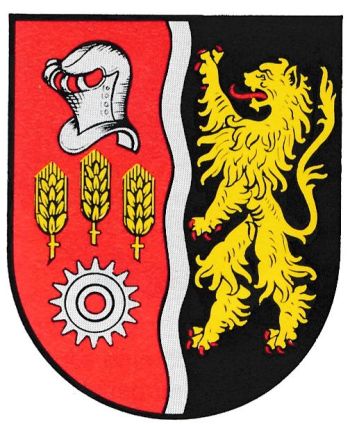Bechhofen (Pfalz): Difference between revisions
Jump to navigation
Jump to search
Knorrepoes (talk | contribs) No edit summary |
Knorrepoes (talk | contribs) No edit summary |
||
| Line 24: | Line 24: | ||
The arms were officially granted on June 2, 1986. | The arms were officially granted on June 2, 1986. | ||
The | The first attempts of the local council to adopt arms date from 1950. At the time the council wanted a canting Pechofen (an oven to make wood-tar) and a helmet as a symbol for the medieval Knights of Bechhofen. However, no arms were granted. | ||
In the new arms the helmet remained and were combined with symbols for agriculture and industry on the right half. The colours are those of their predecessors, the Counts of Homburg. The lion is taken from the arms of the Dukes of Pfalz-Zweibrücken, who ruled the village until 1793. | |||
The wavy pale symbolises the Lambsbach river that flows from South to North through the municipality. | |||
[[Civic Heraldry Literature - Germany|'''Literature''']]: Debus, 1988 | [[Civic Heraldry Literature - Germany|'''Literature''']]: Debus, 1988 | ||
Revision as of 05:13, 16 May 2023
|
Country : Germany State : Rheinland-Pfalz District (Kreis) : Südwestpfalz Verbandsgemeinde: Zweibrücken-Land |
| German | Von Rot und Schwarz durch einen silbernen Wellenstab gespalten, rechts drei senkrecht stehende goldene Ähren, darüber ein silberner Spangenhelm, darunter ein silbernes Zahnrad, links ein rotbezungter und -bewehrter goldener Löwe. |
| English | Shield parted by a pallet wavy Argent, at dexter Gules three grain ears Or in fess between a helm Argent on chief and a cogwheel of the same on base, at sinister Sable a lion rampant Or armed and tongued Gules. |
Origin/meaning
The arms were officially granted on June 2, 1986.
The first attempts of the local council to adopt arms date from 1950. At the time the council wanted a canting Pechofen (an oven to make wood-tar) and a helmet as a symbol for the medieval Knights of Bechhofen. However, no arms were granted.
In the new arms the helmet remained and were combined with symbols for agriculture and industry on the right half. The colours are those of their predecessors, the Counts of Homburg. The lion is taken from the arms of the Dukes of Pfalz-Zweibrücken, who ruled the village until 1793.
The wavy pale symbolises the Lambsbach river that flows from South to North through the municipality.
Literature: Debus, 1988




